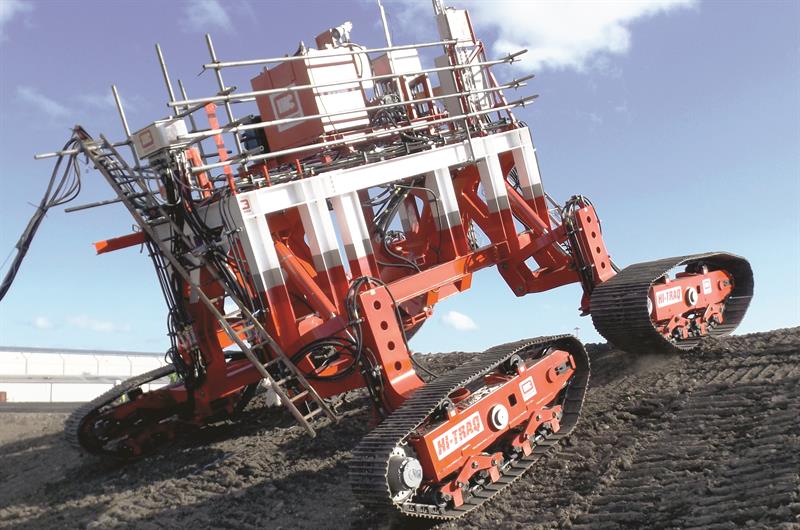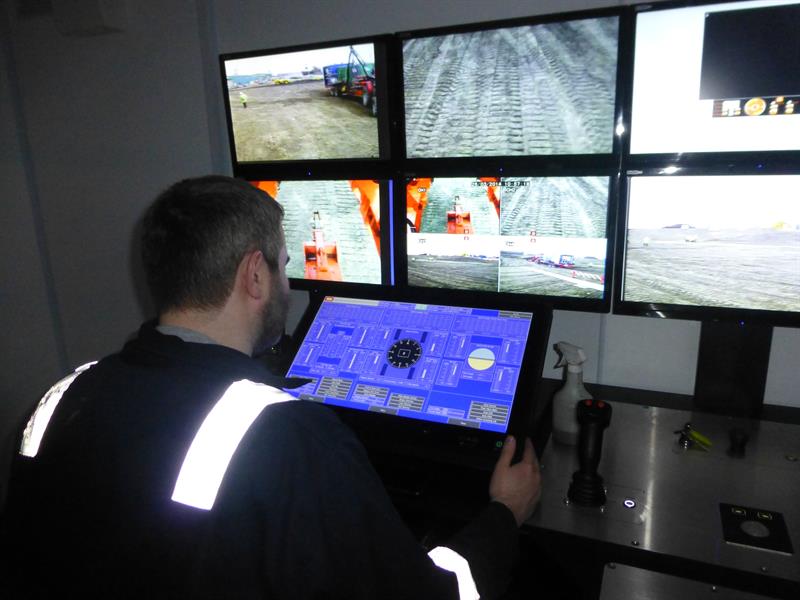IHC Engineering Business had been approached by various companies regarding trenching in the offshore renewables market. It decided to dedicate extensive research and development into investigating innovative methods that would challenge existing technologies and ultimately lower the 'levelised cost of energy' (LCOE) for offshore renewables. The product that emerged from the programme was HiTraq - an innovative fourtrack subsea crawler vehicle designed to be a tooling platform to facilitate a range of activities.
The design intent for the Hi-Traq was to mitigate the problems and operational downtime incurred using conventional oil and gas assets during inter-array cable burial. This was achieved through the application of a crawler vehicle with four tracks and a self-levelling system. The Hi-Traq's four track system gives the necessary traction performance required for the sort of subsea terrain associated with shallow water. The harsh seabed environment found at the offshore renewable locations dictated the requirement for a highly manoeuvrable system which resulted in a chassis from which a variety of subsea tasks can be conducted.
William Stephenson, IHC's product manager for Subsea Vehicles, said that the aim had been to use proven, reliable engineering in a new configuration to facilitate more efficient operations in the challenging subsea conditions. "The vehicle was designed from the ground up starting with a blank sheet of paper by looking at industry lessons learned, the causes for recent project delays and by examining the issues faced by existing equipment operating in shallow water locations," he said. "Well established and best practice approaches were taken during the design phase but the vehicle format is completely new. We have used reliable and robust engineering techniques with standard cylinders and pins."
An analysis of current trenching technologies found that although there are a range of tools operating in the field, none have been designed specifically for offshore inter-array cable burial. Current trenching equipment was designed for the installation of oil and gas lines (heavy subsea crawlers and large free swimming ROVs) or the burial of telecommunication cables across long distances (ploughs). The offshore renewable locations are found in shallow waters which are subject to strong currents and wave action leading to significant seabed sand waves and mega ripples which make trenching using conventional assets problematic. Free swimming trenching alternatives can risk damage to the cable as they have difficulties staying on-station in these strong current conditions.
 |
Another consideration is that as an inter-array cable exits a turbine there is a short radius bend before the straight cable runs to the next turbine. Conventional trenching equipment cannot trench to a short radius and thus secondary protection methods such as mattressing or rock dumping must be employed to protect the cable up to the buried section. This secondary protection method is expensive and increases the difficulty of cable maintenance or repair operations. The ideal solution was for a crawler system, capable of staying on-station in strong currents, to be able to trench straight from the base of a turbine including the trenching of the short radius bends.
Stephenson commented: "The biggest design challenges were the packaging of all of the required equipment into a relatively condensed platform and to design a rotating depressor which can allow safe cable burial operations around short radius bends."
The HiTraq features independent track steering allowing three forms of steering; crab, skid and wagon steering. This allows small radius trenching required for inter-array cables as they leave a turbine. The tracks are independently driven which provides increased control and mitigates the track skidding that would occur when trenching in wagon steering mode.
The four track drive and four track steering system also enables constant cutter face pressure ensuring maximum efficiency from the cutting tool. The nonparallel wishbone levelling geometry for the vehicle was designed to keep the virtual pivot point at the ground to cutter interface, which enables the vehicle to cut a constant depth trench on side slopes. The vehicle also has a patented tilting function using the levelling system to trench around a radius, and avoid undercutting the outside trench wall.
Independent track levelling provides more than 2.15m of vertical movement for obstacle climbing. The independent pitch on all four track units of ±20° prevents spanning as the vehicle ascends a slope and provides a smooth transition over the top of crests compared to two track systems which have a tipover point. The vehicle's self-levelling system automatically adjusts to keep the chassis level which ensures constant trench depth and vertical trench walls even when negotiating sand waves and uneven terrain.
Beyond trenching, IHC EB aims to use the Hi-Traq chassis as a platform for peripheral tooling. The four track system provides a low ground contact pressure to allow operations in soft soil conditions. Stephenson added: "The Hi-Traq uses inter-changeable tooling cartridges to operate different trenching tools and uses additionally tooling packages on a plug and play basis to conduct other operations such as subsea excavation and subsea handling."
The HiTraq has the capacity to stay on-station in the high currents and wave action found at offshore renewable locations and so reduces operational downtime associated with conventional equipment.
 |
Cost is all important – and its ability to work in bad sea and subsea conditions makes the Hi-Traq's availability important."Accordingly the vehicle will be able to perform more operations in a given time period which reduces the number of required vessel days," said Stephenson. "Vessel days are expensive - in the region of £80k/day - and so any improvements to efficiency, and thus a reduction in vessel days, can create significant cost savings. Additionally, the Hi-Traq can trench closer to the turbine than many alternative vehicles which reduces the requirement for second-end operations such as rock placement or mattressing. Both of these activities are expensive and require significant vessel time over an entire offshore wind farm."
Such advances are critical if the offshore renewable sector is to grow, as Stephenson explained: "Presently the industry as a whole is working towards lowering the LCOE for offshore renewables to make the sustainable energy source more competitive with fossil fuel alternatives. Continual technology advancements are required to make installation, operation and maintenance, and ultimately decommissioning operations less expensive in order to reduce our reliance on fossil fuel powered energy generation."
The technology is scalable and therefore adaptable to the clients' requirements ranging from a lightweight, jetting only vehicle to a large platform for larger scale installation and decommissioning operations. The first Hi-Traq IHC will be bringing to market will be approximately 42t in air and is specifically aimed at the North Sea market.











